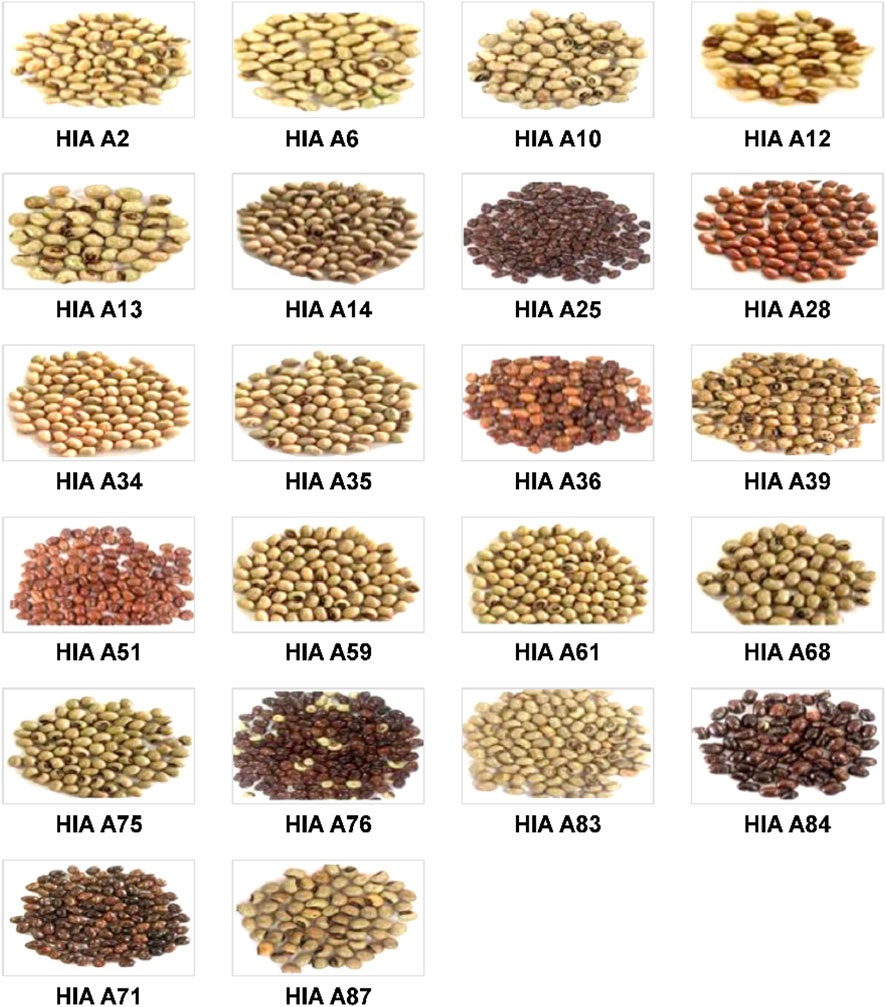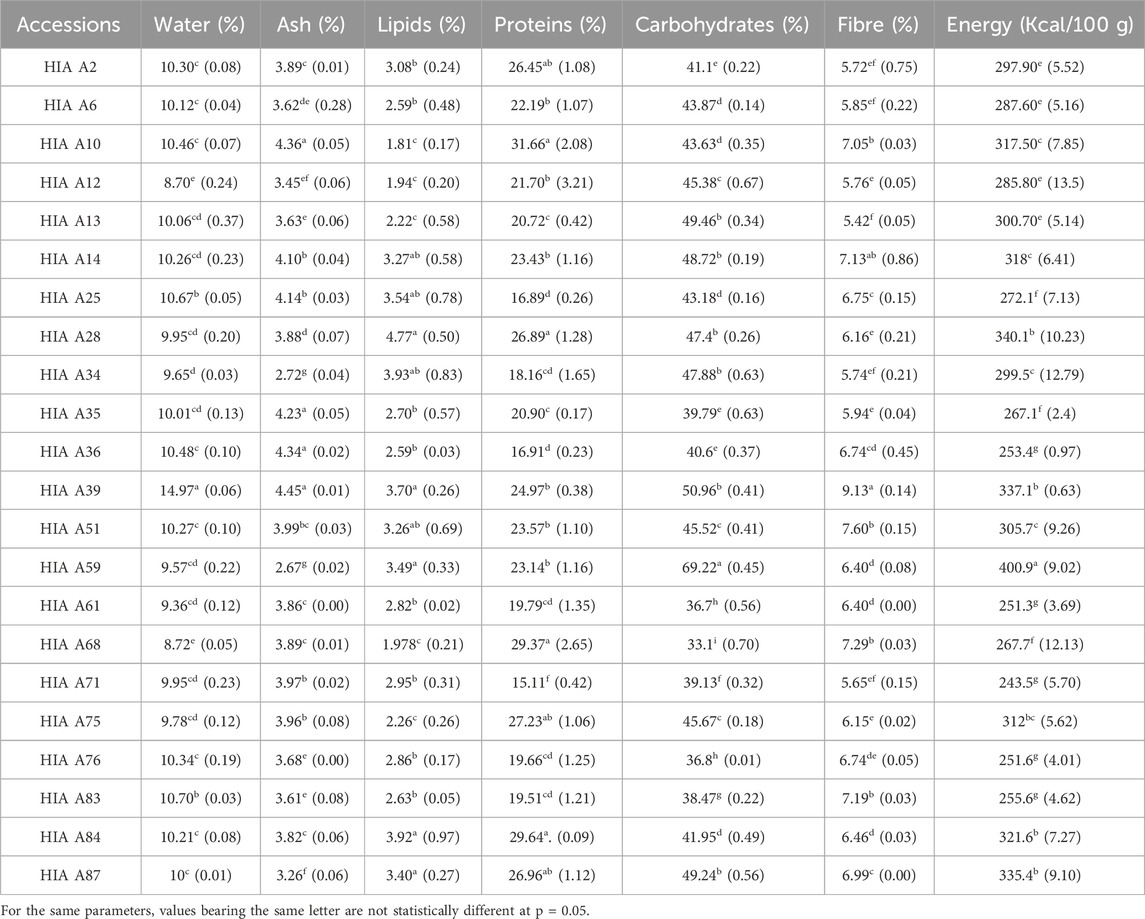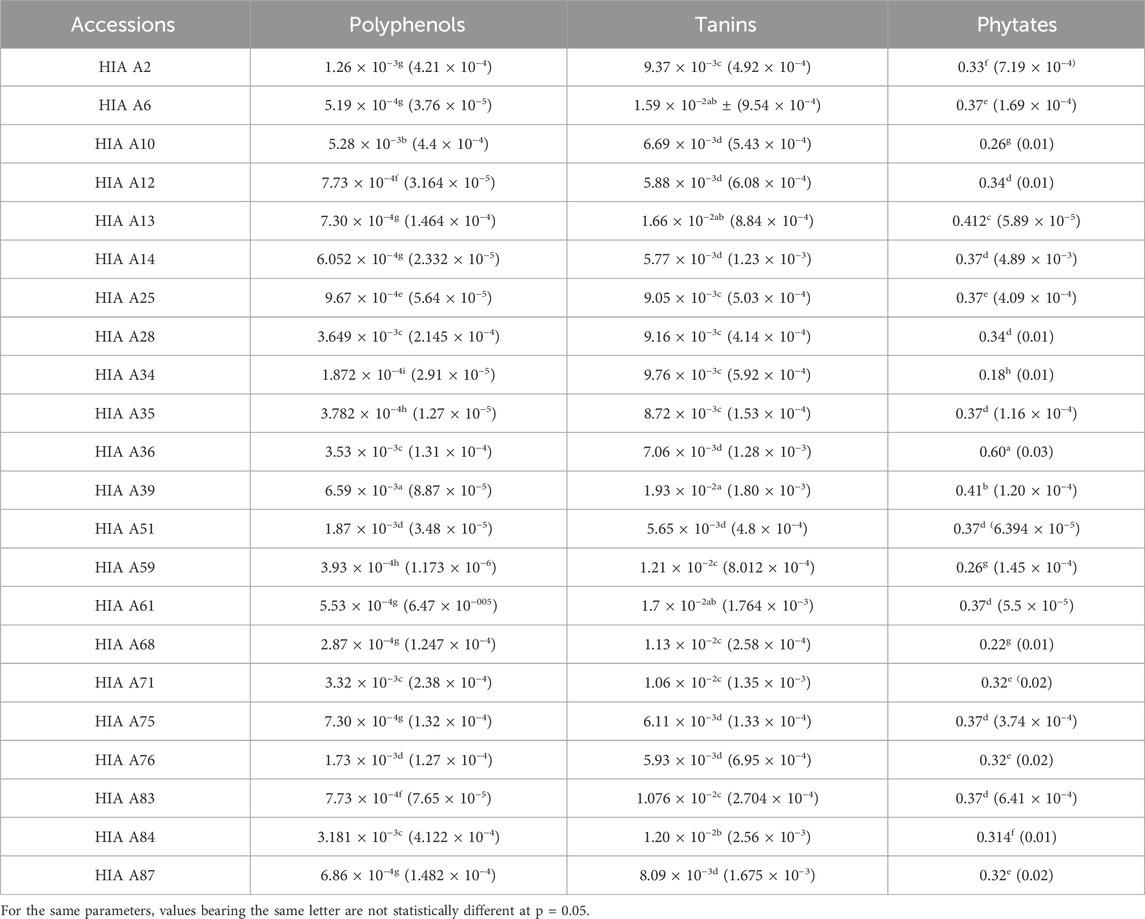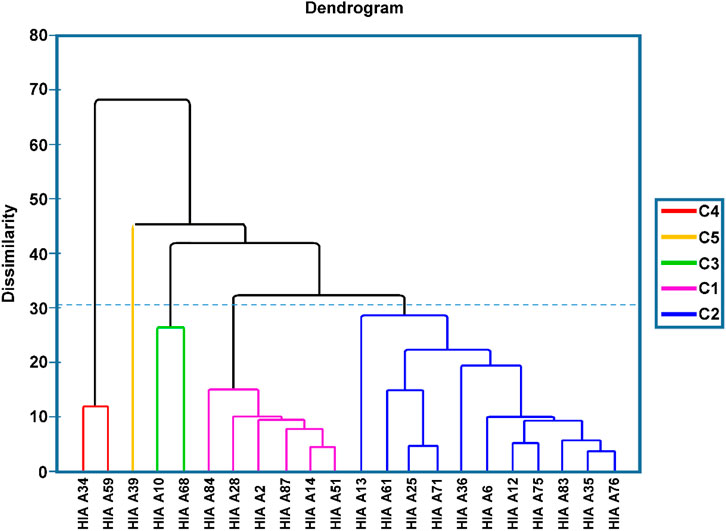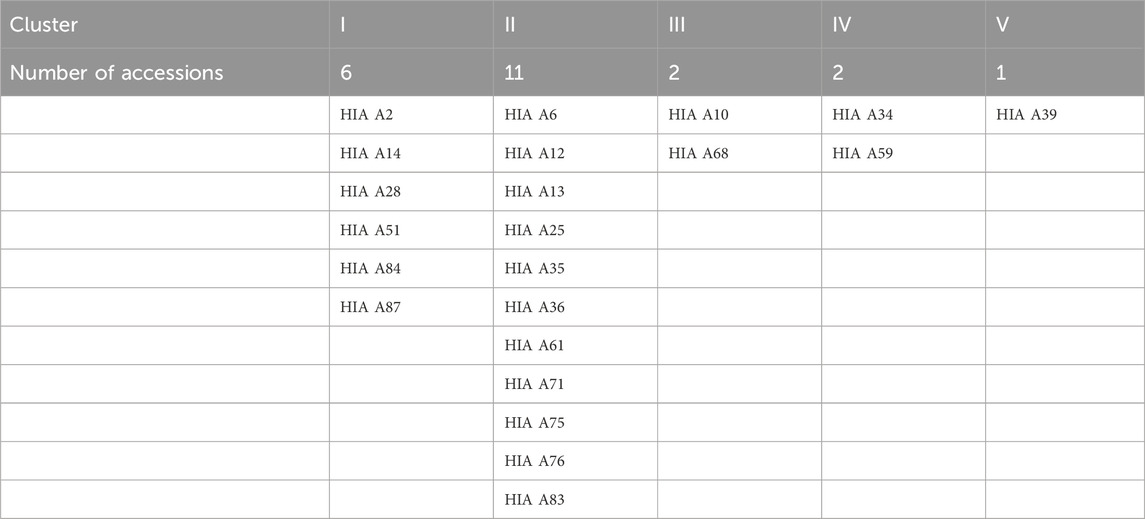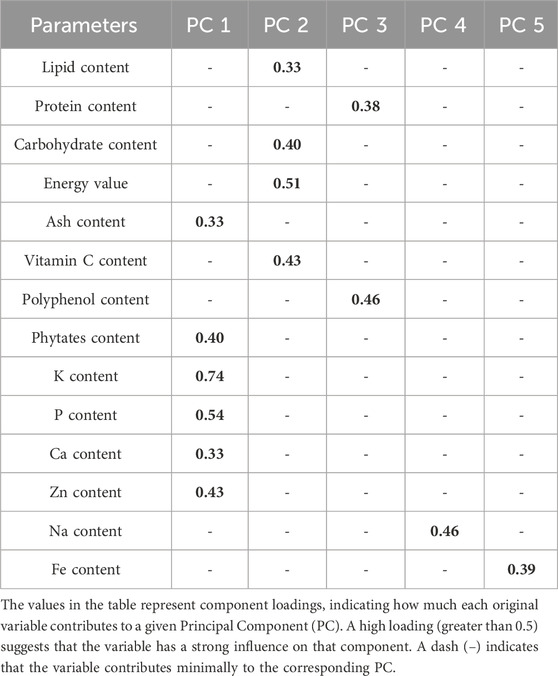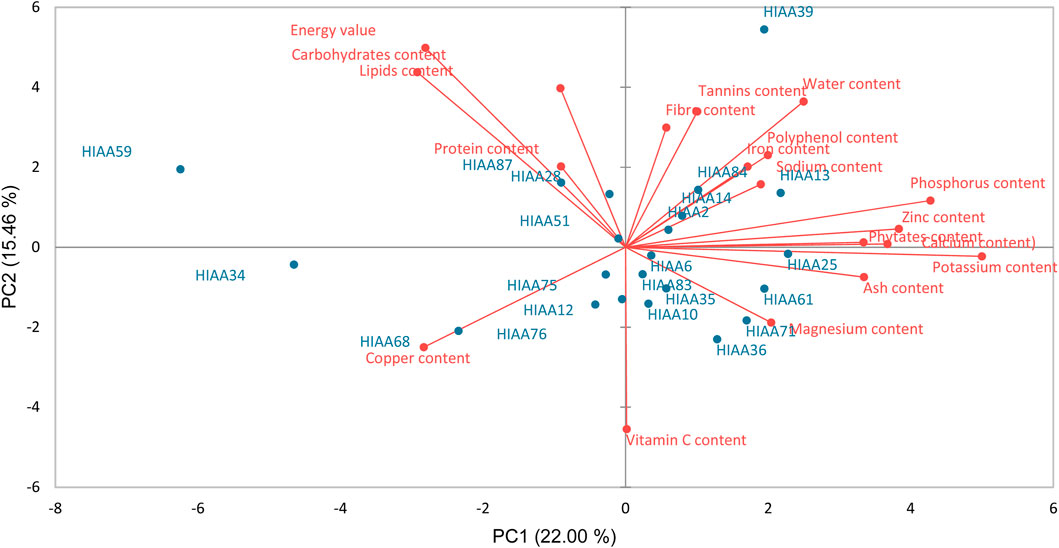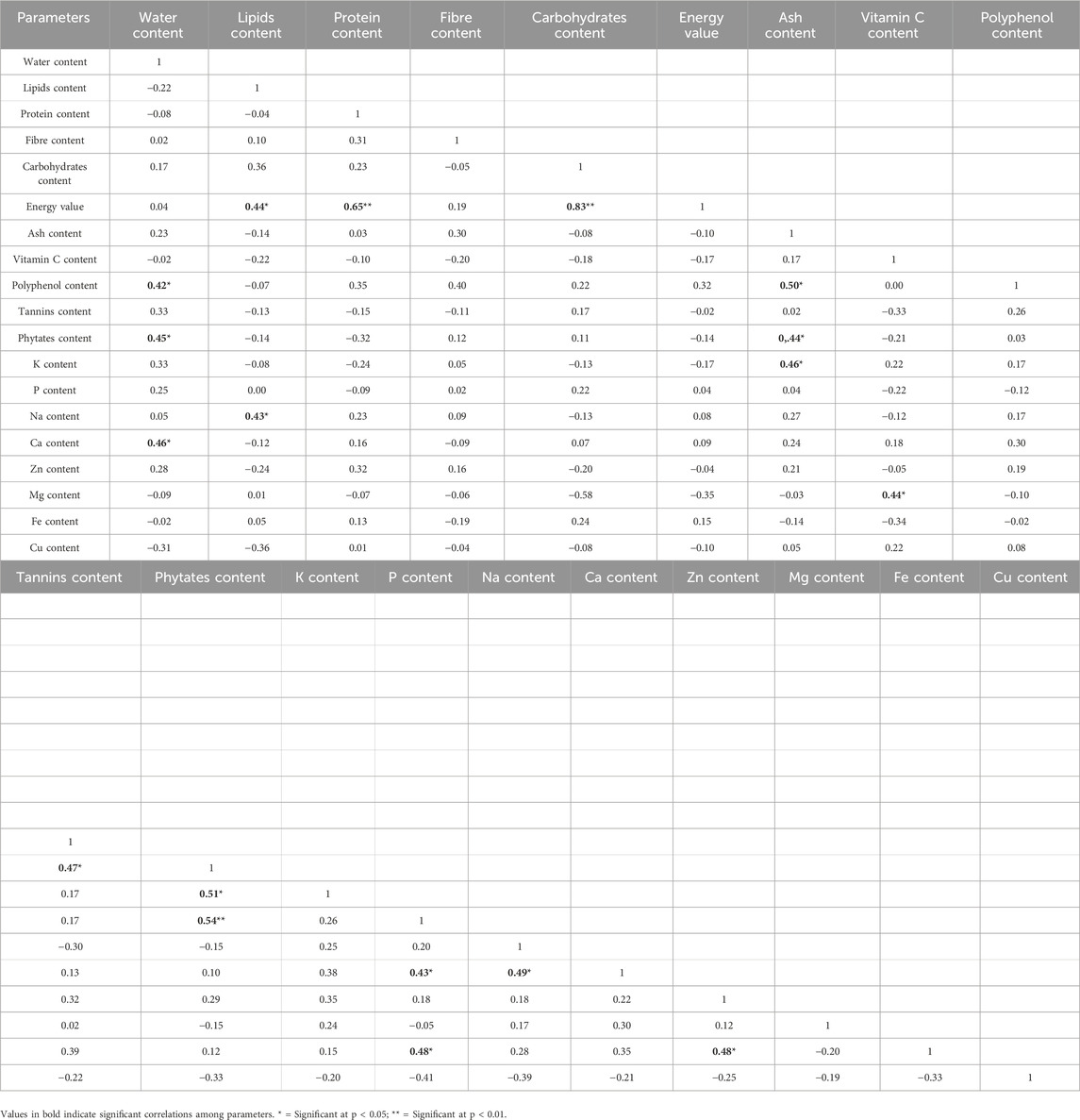- 1Laboratoire des Sciences Agronomiques et Biologiques Appliquées, Université de Kara, Kara, Togo
- 2Centre de Recherche Agronomique du Littoral-Institut Togolais de Recherche Agronomique (ITRA-CRAL), Davié, Togo
- 3Centre de Recherche Agronomique Savane Sèche-Institut Togolais de Recherche Agronomique (CRASS-ITRA), Kara, Togo
- 4Laboratory of Applied Ecology, Université d’Abomey Calavi, Cotonou, Benin
Introduction: African yam bean (AYB) is a native legume crop from Africa with significant nutritional and health potential. In Togo, however, the crop remains underutilized and neglected due to a lack of awareness of its substantial potential. This study aimed to analyze seeds from different accessions of AYB cultivated in Togo in order to compare their biochemical properties and identify superior genotypes that could be promoted in the Togolese population's diet through direct consumption or food fortification.
Methods: Twenty-two accessions of AYB cultivated in Togo were profiled for their nutritional composition, antinutritional factor content, and mineral composition.
Results and Discussion: The accessions were grouped into five clusters: cluster II was prominent with 11 accessions, while cluster V had only one accession. Accessions HIA A10, HIA A13, HIA A14, HIA A28, HIA A39, HIA A68, HIA A84, HIA A2, HIA A75, and HIA A87 exhibited desirable levels of nutrients such as protein, fiber, Mg, and Fe, which could be exploited for the further development of AYB in Togo. Correlation analysis revealed low to moderate positive and significant (P < 0.05) association between some parameters such as Mg and Vit C or P and Ca indicating that such parameters could be simultaneously selected during programs aimed at improving the nutritional quality of AYB accessions.
Background
Malnutrition is the cause of at least half of all child deaths worldwide. This public health issue is particularly severe in developing countries, leading to chronic deficiencies in energy, protein, or micronutrients in children under five (Yue et al., 2022). Many of these countries face the “triple burden” of malnutrition, which is characterized by the coexistence of undernutrition, micronutrient deficiencies, and overweight or obesity (FAO, 2019). This phenomenon affects millions of people worldwide, impacting households and entire populations throughout their lives, resulting in losses of human capital and hindering economic growth.
Togo, like most African nations, grapples with the triple burden of malnutrition. According to a demographic and health survey, 23.7% of children under five in Togo suffer from stunting, and 6.7% experience acute malnutrition. Micronutrient deficiencies are also widespread, with high rates of vitamin A deficiency (35%) and anemia (74%) among children under five. The prevalence of anemia remains high among adults, affecting 48% of women aged 15%–45% and 64% of pregnant women (FAO, 2019).
Despite these challenges, many locally adapted, highly nutritious native African crops that are resilient to the biotic and abiotic stresses exacerbated by climate change, such as the African yam bean (AYB) (Sphenostylis stenocarpa), are threatened with extinction (Akpavi et al., 2008; Batawila et al., 2005). AYB is a legume used by local populations in West and Central Africa to supplement their diets with essential amino acids and protein, due to the high cost of animal protein (Toyosi et al., 2020). The plant produces seeds that vary in size, shape, and hull color, as well as highly nutritious tuberous roots. Its amino acid profile meets the FAO’s daily dietary requirements and is considered superior to most legumes, even comparable to that of whole chicken eggs (Gbenga-Fabusiwa, 2021). Furthermore, the crop can withstand adverse conditions, including prolonged drought (Toyosi et al., 2020). Beyond their high nutritional value, the beans from this crop contain phytochemicals that may help reduce the risk of diseases such as cardiovascular disorders and other degenerative conditions, suggesting that AYB could be beneficial for individuals suffering from cardiovascular disease (Ade-Omowaye et al., 2015; Oboh, 2006; Soetan et al., 2018).
However, despite its immense potential for improving food security, nutrition, and resilience to environmental stresses, AYB has not yet been widely cultivated and integrated into the Togolese agricultural system. The underutilization of this crop can be partly attributed to limited knowledge about the species, its long cooking time, its relatively long vegetative cycle (7–8 months), the dietary habits of the population, and the presence of antinutritional factors such as tannins, phytates, and oxalates in the seeds (Baudoin and Ngansia, 2004). These antinutritional factors can interfere with the absorption or bioavailability of nutrients. However, some can be beneficial when consumed in appropriate amounts (Shitta et al., 2022). Biochemical characterization of a species, including analysis of proteins, lipids, carbohydrates, fiber, vitamins, minerals, tannins, oxalates, and phytates, is essential for guiding the adoption of these crops by the population. However, little research has been conducted on AYB germplasm in Togo, and the main attributes of this germplasm remain unknown. This information is important for utilizing and exploiting neglected and underused crops such as AYB for breeding purposes, food processing, and nutrition. Therefore, to contribute to the sustainable promotion of the genetic resources of S. stenocarpa, this study aims to assess the nutritional value and biochemical composition of AYB accessions grown in Togo. Specifically, it aims to determine the proximate and mineral composition, macronutrient levels, and the presence of antinutritional factors (phytates, tannins, polyphenols) in AYB accessions cultivated in Togo, with the goal of identifying contrasting genotypes for future breeding programs and promoting the sustainable use of the crop.
Materials and methods
Study zone
The plant material used in this study consists of 22 HIA accessions (Figure 1) supplied by the Centre de Recherche Agronomique du Littoral of the Institut Togolais de Recherche Agronomique, located in Davié (6°23′35.5″N, 1°12′25.5″E), 25 km north of the capital Lomé, in the Maritime region. The Maritime region is characterized by a long rainy season from April to June and a short rainy season from September to October, with dry seasons in between. The average annual rainfall reported from 1991 to 2020 varied from 800 mm near the coast to 1,400 mm in the northern part of the basin. The average annual air temperature ranged from 24 °C to 30 °C. The region’s soil consists of a high proportion of fertile bare soils and ferruginous, ferralitic, and vertisol soils, all of which are generally suitable for agriculture (Barry et al., 2024).
Experimental design
The 22 AYB accessions (Figure 1) were collected during a survey conducted across the country between 2019 and 2021. The seeds used for this study were harvested during the 2020–2021 season, following an alpha-lattice design. A 900 m2 plot (36 m × 25 m) was divided into blocks using the alpha-lattice design with three replicates. Each replicate consisted of four sub-blocks. Each sub-block contained nine elementary plots, which were arranged as ridges 3 m long and 1 m wide. The interval between each replicate was 1.5 m, and the distance between sub-blocks was 1 m. The sowing pattern was 50 cm × 1 m, with three seeds sown per accession. After emergence, weeding was carried out to ensure only one vigorous seedling remained per poquet. Four weedings were performed as required. No chemical treatments were applied to control pests.
Biochemical analysis
The measurements of the different nutrients content were done in triplicate. For the proximate composition, water, ash and protein content were determined as described by AOAC (1990) while lipid content was quantified using the Soxhlet method (AOAC, 2006). The fiber content was determined using the method described by Wolf (1968). Carbohydrates content was determined using spectroscopy following the method described by DuBois et al. (1956). The energy value was obtained as described by Manzi et al. (1999) using the Atwater digestibility coefficients for proteins, carbohydrates and lipids. Minerals were analyzed using an atomic absorption spectrophotometer (AAS) for iron, zinc, copper, and magnesium, and a flame photometer for phosphorus, potassium, sodium, and calcium. For this procedure, 3 g of the sample previously dried and ground to determine water content was weighed into a crucible. The crucible was then placed in a furnace at 550 °C for 6 h. After cooling in a desiccator, the resulting ash was dissolved in a 100 mL volumetric flask by adding 1 mL of nitric acid, filtering through Whatman paper, and diluting with distilled water to the mark (NF EN 14084). The distillate was then read by AAS and flame spectrophotometer through a probe. For the content of Vitamin C, the iodometric method described by Raman et al. (2023) was used. Vitamin C was reacted with a known excess of diiodine (I2). The excess was assayed with a thiosulphate solution in the presence of starch and phosphoric acid. For the antinutritional factor, total phenolic compounds were determined by assay using the Folin-Ciocalteu method described by Cicco and Lattanzio (2011) while the tannins were determined after extraction in 70% methanol using the modified vanillin method of Bainbridge et al. (1996). The phytates content was determined using the method described by Adeyemo and Onilude (2013).
Statistical analysis
Data were compiled in Excel and analyzed using XLSTAT version 2021.2.2. One-way analysis of variance (ANOVA) was used to assess significant differences between the different accessions for each parameter evaluated. The Student–Newman–Keul (SNK) test was used to separate accessions that were statistically different at the 5% level and to compare group means. Spearman’s correlation test was used to assess the association between the different parameters evaluated. Principal component analysis and hierarchical ascending classification were used to group the different accessions and highlight relationships among them.
Results
Proximate composition
The proximate composition of the 22 AYB accessions is shown in Table 1.
The water content of the accessions ranged from 8.70% to 14.97%, with an average of 10.21%. The ANOVA analysis revealed a highly significant difference (p < 0.001) in water content among the accessions. According to the SNK test, accession HIA A39 had the highest water content (14.97%), while accessions HIA A12 and HIA A68 had the lowest water content (8.72% and 8.70%, respectively).
Lipid content ranged from 1.80% for accession HIA A10% to 4.77% for accession HIA A28, with an average of 2.98%. The ANOVA test indicated a highly significant difference (p < 0.001) between the 22 accessions. The SNK test showed no significant difference between the lipid content of HIA A28 and the accessions HIA A39, HIA A59, HIA A84, HIA A87, HIA A51, HIA A34, HIA A25, and HIA A14, which had lipid contents of 4.77%, 3.70%, 3.49%, 3.91%, 3.40%, 3.26%, 3.54%, 3.92%, and 3.26%, respectively. These accessions had the highest lipid contents, while accessions HIA A12, HIA A36, HIA A68, and HIA A75, with lipid contents of 1.94%, 2.59%, 1.97%, and 2.25%, respectively, had lipid contents similar to that of HIA A28.
The protein content of the accessions ranged from 15.11% to 31.66%, with an average of 22.83%. A highly significant difference was observed between the protein content of the accessions. Accessions HIA A10, HIA A28, HIA A68, HIA A84, HIA A2, HIA A75, and HIA A87, with protein contents of 31.66%, 26.89%, 29.37%, 29.64%, 26.45%, 27.23%, and 26.96%, respectively, had the highest protein contents. The SNK test revealed no significant difference among these accessions. Accessions HIA A71 had the lowest protein content (15.11%).
Fiber content ranged from 5.42% to 9.13%, with an average content of 6.73%. The ANOVA revealed a significant difference in fiber content between the 22 accessions. According to the SNK test, accessions HIA A39 and HIA A14 had the highest fiber contents (9.13% and 7.13%, respectively), while accession HIA A13 had the lowest fiber content (5.42%).
Ash content ranged from 2.67% to 4.45%, with an average of 3.73%. ANOVA statistical analysis revealed a highly significant difference in ash content between the accessions. Accessions HIA A10, HIA A35, HIA A36, and HIA A39, with ash contents of 4.35%, 4.22%, 4.34%, and 4.45%, respectively, had the highest ash content, while accessions HIA A34 and HIA A59, with ash contents of 2.72% and 2.67%, respectively, had the lowest.
Carbohydrate content ranged from 33.10% to 69.22%, with an average content of 44.44%. A significant difference in carbohydrate content was observed among the accessions, with accession HIA A59 having the highest carbohydrate content (69.22%) and accession HIA A68 having the lowest (33.10%).
Mineral and vitamin C composition
The mineral and vitamin C composition of the AYB seeds is shown in Table 2. In general, the results indicate a significant amount of K, Ca, P, Fe, Zn, Mg, and vitamin C in the seeds. The ANOVA test showed a significant difference in K, Ca, Fe, P, Zn, Cu, and vitamin C content among the 22 accessions. However, no significant difference was observed for the Mg and Na content among the 22 accessions. K content of the accessions ranged from 958.00 mg/100 g to 1,559 mg/100 g, with an average content of 1334.54 mg/100 g. The SNK test revealed that accession HIA A14 had the highest K content (1559.00 mg/100 g), while accession HIA A34 had the lowest (958.00 mg/100 g). Ca content ranged from 8.57 mg/100 g to 12.71 mg/100 g, with an average of 10.75 mg/100 g. Accession HIA A10 had the highest Ca content (12.71 mg/100 g), while accession HIA A59 had the lowest (8.57 mg/100 g). Fe content ranged from 1.56 mg/100 g to 5.25 mg/100 g, with an average of 2.64 mg/100 g. Accession HIA A13 had the highest Fe content (5.25 mg/100 g), while accession HIA A51 had the lowest (1.56 mg/100 g). P content ranged from 176.20 mg/100 g to 338.50 mg/100 g, with an average of 274.33 mg/100 g. Accession HIA A13 had the highest P content (338.50 mg/100 g), while accession HIA A34 had the lowest (176.20 mg/100 g). Zn content varied from 0.12 mg/100 g to 2.26 mg/100 g, with an average of 1.84 mg/100 g. Accession HIA A13 had the highest Zn content (2.26 mg/100 g), while accession HIA A34 had the lowest (0.12 mg/100 g). Cu content ranged from 0.03 mg/100 g to 0.18 mg/100 g, with an average of 0.11 mg/100 g. Accession HIA A39 had the highest Cu content (0.18 mg/100 g), while accession HIA A71 had the lowest (0.03 mg/100 g). Cu was not detected in 13 of the 22 accessions (HIA A2, HIA A6, HIA A12, HIA A14, HIA A25, HIA A28, HIA A35, HIA A36, HIA A51, HIA A61, HIA A76, HIA A83, HIA A84, and HIA A87). The vitamin C content of the accessions ranged from 3.01 mg/100 g to 8.59 mg/100 g, with an average of 3.96 mg/100 g. Accession HIA A10 had the highest vitamin C, while accessions HIA A76 and HIA A35 had the lowest levels (3.01 mg/100 g and 3.29 mg/100 g, respectively). Mg content of the AYB accessions ranged from 139.10 mg/100 g to 227.80 mg/100 g, with an average of 185.82 mg/100 g, while Na content ranged from 5.53 mg/100 g to 14.15 mg/100 g, with an average of 7.22 mg/100 g. No significant differences were observed between the accessions (Table 2).
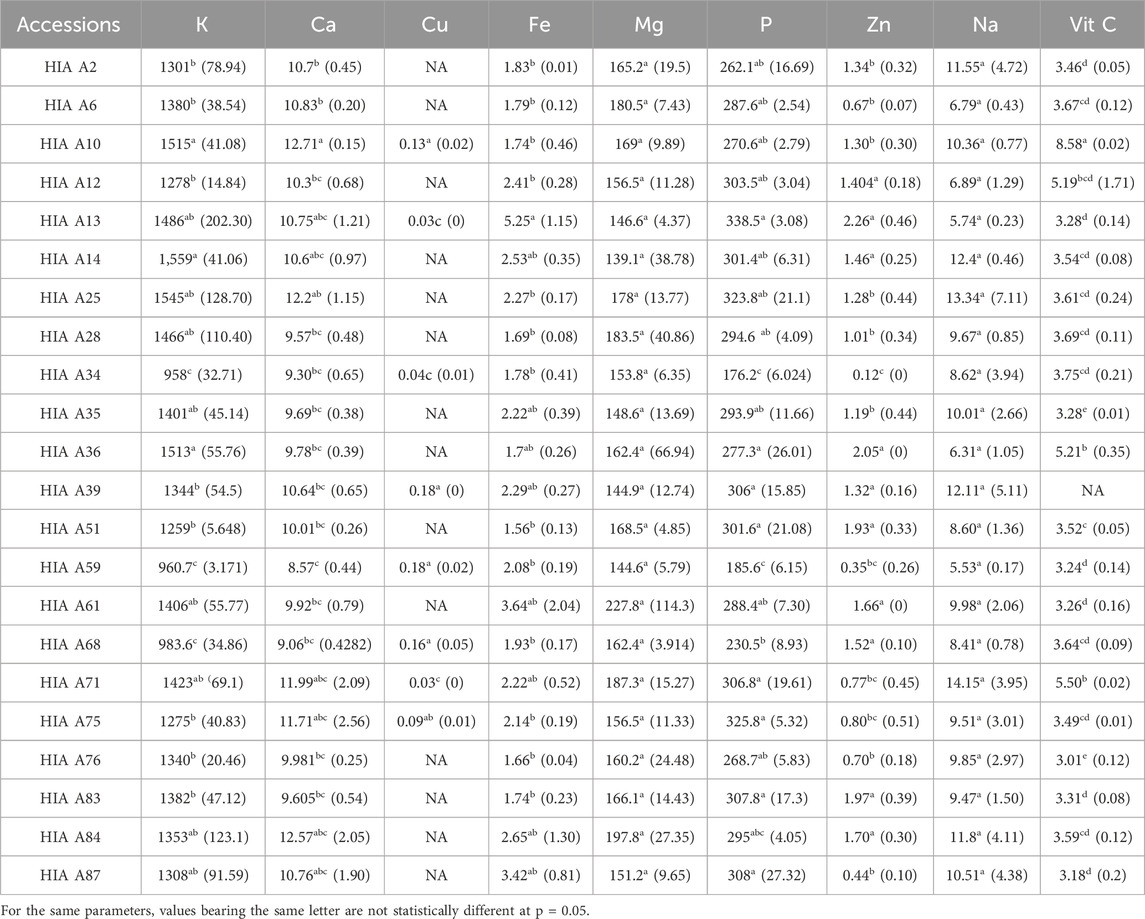
Table 2. mineral and vitamin C content in mg/100 g of the 21 African yam bean accessions (mg/100 g).
Composition of antinutritional factors in the 22 AYB accessions
The results of the antinutritional factor content are shown in Table 3. ANOVA analysis revealed significant differences between the 22 accessions for the three antinutritional factors evaluated. The polyphenol content of the HIA accessions ranged from 1.87 × 10−4% to 6.60 × 10−3%, with an average content of 1.70 × 10−3%. Accession HIA A39, with a polyphenol content of 6.60 × 10−3%, had the highest significant polyphenol content, while accession HIA A34, with a content of 1.87 × 10−4%, had the lowest. The tannin content of the HIA accessions analyzed ranged from 5.65 × 10−3% to 1.93 × 10−2%, with an average content of 0.010%. Accessions HIA A10, HIA A12, HIA A14, HIA A36, HIA A51, HIA A75, HIA A76, and HIA A87, with tannin contents of 6.69 × 10−3%, 5.88 × 10−3%, 5.77 × 10−3%, 7.06 × 10−3%, 5.65 × 10−3%, 6.11 × 10−3%, 5.93 × 10−3%, and 8.09 × 10−3%, respectively, had the lowest tannin contents. In contrast, accessions HIA A39, HIA A6, HIA A13, and HIA A61, with tannin contents of 5.66 × 10−3%, 1.59 × 10−2%, 1.66 × 10−2%, and 1.70 × 10−2%, respectively, had the highest levels. Phytate content varied from 0.18% to 0.60%, with accession HIA A34 having the lowest content and accession HIA A36 having the highest content (Table 3).
Hierarchical cluster analysis
The hierarchical cluster analysis performed on the 22 accessions based on biochemical parameters revealed five clusters (Figure 2; Table 4). Cluster II was the most prominent, containing 11 accessions. It was followed by Cluster I, consisting of six accessions; Clusters III and IV, with two accessions each; and Cluster V, which contained only one accession (HIA A39). Table 4 shows the hierarchical cluster details.
Table 5 presents the analysis of variance for the biochemical composition of the 22 AYB accessions following the clustering. Highly significant differences (p < 0.01) were found among the clusters for all the measured parameters, except for Ca, Fe, Mg, and Na content. Accessions in Cluster III had the highest protein content, with a mean value of 30.52%. However, this content was not significantly different from that of Cluster I (26.16%) and Cluster V (24.97%), but it significantly differed from the protein content of accessions from Cluster II (19.84%) and Cluster IV (20.65%).
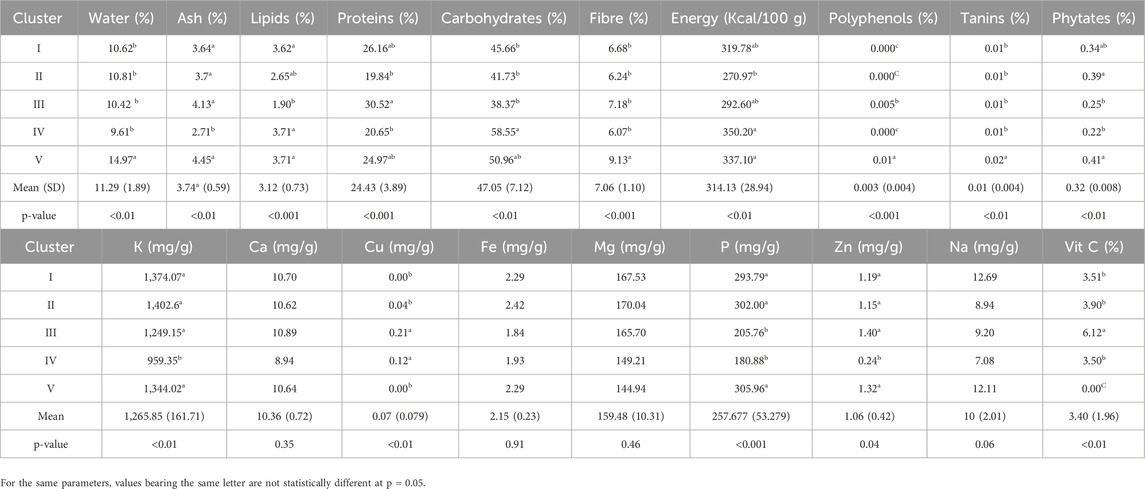
Table 5. Analysis of variance of the biochemical composition of the 22 African yam bean accessions by hierarchical cluster.
Regarding ash content, accessions from Cluster IV had the lowest values compared to accessions from Clusters I, II, III, and V, which had similar ash content values: 3.34%, 3.78%, 4.13%, and 4.45%, respectively. For water content, Cluster IV had a content of 9.61%, which was significantly higher than the values of the other clusters (10.62%, 10.81%, 10.42%, and 14.97%, respectively, for Clusters I, II, III, and V). The highest carbohydrate content was recorded for Cluster IV (58.55%), which was similar to that of accession HIA A39, which alone constituted Cluster V. Clusters I, II, and III, with carbohydrate contents of 45.66%, 45.66%, and 38.37%, respectively, had statistically similar carbohydrate content. For the energy value, accessions from Cluster IV, with a mean energy value of 350.20 kcal/100 g, had the highest energy value; however, this value was not statistically different from the 337.10 kcal/100 g of accession HIA A39 and the mean values of accessions from Clusters I (319.78 kcal/100 g), III (292.60 kcal/100 g), and IV (350.20 kcal/100 g). Accessions from Cluster III had the lowest mean energy value (292.60 kcal/100 g). Accession HIA A39 also displayed a statistically higher fiber content (9.13%) compared to accessions from Cluster I (6.68%), Cluster II (6.24%), Cluster III (7.18%), and Cluster IV (6.07%). The highest vitamin C content (6.12%) was recorded for accessions in Cluster III.
For the antinutritional factors (tannins, polyphenols, and phytates), it was again accession HIA A39 that displayed the highest values (0.01% for polyphenols, 0.02% for tannins, and 0.41% for phytates).
Regarding mineral content, accessions from Cluster IV had statistically lower K (959.35 mg/g), P (180.88 mg/g), and Zn (0.24 mg/g) content compared to accessions from the other clusters. The K content of accessions in Cluster II (1402.60 mg/g), which was the highest, was not significantly different from the content obtained from accessions of Cluster I (1374.07 mg/g), Cluster III (1249.15 mg/g), Cluster IV (1249.15 mg/g), and Cluster V (1344.02 mg/g). The highest P content was recorded for accessions in Cluster V (305.96 mg/g), although the content was not significantly different from the values recorded for Cluster I and Cluster II. The highest Zn content was recorded for accessions in Cluster III (1.40 mg/g), although this content was not significantly different from the values for accessions in Clusters I (1.19 mg/g), II (1.15 mg/g), and V (1.32 mg/g).
Principal component analysis
Principal component analysis was performed to determine the most discriminative variables among the 22 AYB accessions. The results showed that the first five principal component (PC) axes cumulatively explained 70.06% of the observed variation, with PC 1 to PC 3 accounting for 50.37% of the total variation in the studied accessions. The first axis, which explained 22% of the variation, was positively correlated (correlation coefficient >0.30) with ash content (0.33), phytate content (0.40), K content (0.74), P content (0.54), Ca content (0.33), and Zn content (0.43). PC axis two contributed 15.47% of the total variation across the traits and was positively correlated with lipid content (0.33), carbohydrate content (0.40), energy value (0.51), and vitamin C content (0.43). Protein content (0.38) and polyphenol content (0.46) were positively correlated with PC axis 3, while Na content and Fe content were positively correlated with PC axis 4 (0.46) and PC axis 5 (0.39), respectively (Table 6).
Figure 3 provides a summary of the biplot analyses of the 22 accessions based on the measured parameters. Accessions HIA A28, HIA A51, HIA A59, and HIA A87 showed positive correlations with protein content, lipid content, carbohydrate content, and energy value, while these parameters were negatively correlated with accessions HIA A6, HIA A10, HIA A25, HIA A35, HIA A36, HIA A61, and HIA A83. The latter accessions were positively correlated with Mg, K, and ash content. Accessions HIA A2, HIA A13, HIA A14, and HIA A84 showed positive correlations with fiber, tannins, polyphenols, phytate, water, Fe, Na, P, Zn, and Ca content. In contrast, these parameters were negatively correlated with accessions HIA A12, HIA A34, HIA A68, HIA A75, and HIA A76, which showed positive correlations with Cu content.
Association among traits
There were correlations between pairs of the studied parameters (Table 7). The energy value was positively correlated with lipid content (p < 0.05, rs = 0.44), carbohydrate content (p < 0.01, rs = 0.65), and protein content (p < 0.01, rs = 0.83). A significant (p < 0.05) positive correlation was also observed between polyphenol content and water content (rs = 0.4), phytate content and water content (rs = 0.45), Ca content and water content (rs = 0.46), Na content and lipid content (rs = 0.43), polyphenol content and ash content (rs = 0.50), phytate content and ash content (rs = 0.44), K content and ash content (rs = 0.46), Mg content and vitamin C content (rs = 0.44), phytate content and tannin content (rs = 0.47), K content and phytate content (rs = 0.51), Ca content and Na content (rs = 0.49), Ca content and P content (rs = 0.43), Fe content and P content (rs = 0.48), and Fe content and Zn content (rs = 0.48). A significant correlation was also observed between P content and phytate content (p < 0.01, rs = 0.54).
Discussion
Variability in proximate and mineral composition of the AYB accessions
The nutritional content of the AYB accessions varied considerably, primarily due to their unique genetic makeup and the environments where they originated (Gore et al., 2021; Majola et al., 2025). The amount of water (10.21%) was low enough for safe storage (less than 14.5%), aligning with earlier reports (Adebowale et al., 2009; Gore et al., 2021). The levels of protein (22.83%) was quite good and matched findings from Baiyeri et al. (2018), suggesting that these varieties are a potentially good source of protein, particularly the HIA A10, HIA A28, and HIA A2 varieties. These accessions could be used by consumers and breeders respectively for protein enrichment and breeding purposes. The ash content of the 22 AYB accessions was relatively high, supporting the idea that they may be good sources of dietary minerals. The fat content (2.98%) was on the lower side, similar to what Ndidi et al. (2014) reported, which could make them easier to process and more stable during storage (Baiyeri et al., 2018). The amounts of carbohydrates (44.44%) and energy (296.46 kcal/100 g) were less than what Baudoin and Ngansia (2004) and Anya and Ozung (2019) found whereas the amount of fiber (6.73%) was in the middle range, as described by Baiyeri et al. (2018). The discrepancies between the results of this study and those reported by other researchers may be explained by the differences in genetic material used, as well as the different growing conditions of the studied AYB accessions. Several studies have reported the important role of environmental factors, such as soil fertility and ambient conditions, in the nutritional variation of accessions from different regions. These differences compared to past research can also be attributed to how the crops were handled after harvesting (Gore et al., 2021; Shi et al., 2008; Stangoulis et al., 2007).
The average protein content of the AYB accessions of this study is more than the values reported by other legume crops cultivated in sub-saharan Africa like Bambara groundnuts, Adzuki beans, Jack beans, Lima beans and rice bean but is less than the ones reported for Mung beans and Wing beans (Popoola et al., 2023). Regarding the carbohydrate content (44.44%), the average value obtained in this study is quite high compared to the ones reported for Lima bean, Mung bean and Win bean (Popoola et al., 2023). Johnson et al. (2022) have reported that legume carbohydrates have the ability to greatly improve health and ensure nutritional quality since they resistant starch sugars that can improve the microbial environment in our gastrointestinal tract and promote gut metabolism. Therefore, the AYB accessions in this study are good candidates for improving human nutrition and health.
Minerals play a crucial role in the growth and development of bones and teeth, as well as in the proper functioning of muscles and nerves (Razzaque and Wimalawansa, 2025). Therefore, in West African countries, legumes crops are vital sources of essential, which are often lacking in local diets and contribute to widespread malnutrition and anemia, particularly among children and women (Popoola et al., 2023). Mineral analysis of the Togolese AYB accessions revealed considerable variation, except in sodium and magnesium. Potassium was the most abundant mineral (1334.54 mg/100 g), exceeding AYB levels reported by Adeyeye et al. (1994) and Oshodi et al. (1997), as well as those in Bambara groundnut in Bambara groundnut (983.86 mg/100 g) (Majola et al., 2025), but remaining below pigeonpea levels (1895.67 mg/100 g) (Amarteifio et al., 2002). Calcium (10.75 mg/100 g) was higher than previous AYB findings (Adeyeye et al., 1994; Oshodi et al., 1997) but lower than values reported in Bambara groundnut (187.09 mg/100 g) and pigeonpea (123.83 mg/100 g) (Majola et al., 2025). Phosphorus content (274.33 mg/100 g) was within the range reported by Oshodi et al. (1997) and higher than values from Adeyeye et al. (1994), though still lower than the values of 823.28 mg/100 g and 205.67 mg/100 g respectively reported for Bambara groundnut and pigeonpea (Adeyeye et al., 1994; Amarteifio et al., 2002). The mean sodium content (7.22 mg/100 g) was within the range of 1.73–8.23 mg/100 g reported by Oshodi et al. (1997) and higher than the 4.87 mg/100 g reported by Adeyeye et al. (1994), but lower than the 9.90 mg/100 g recorded for pigeonpea by Oshodi et al. (1993). Magnesium (185.82 mg/100 g) exceeded both earlier AYB data by Adeyeye et al. (1994) and Oshodi et al.(1997) and pigeonpea values (Amarteifio et al., 2002).
Potassium, sodium, phosphorus, magnesium and calcium are macrominerals required by the human body in relatively large amounts, typically more than 100 mg per day. They play vital roles in human health. Potassium is an essential mineral that plays a vital role in maintaining overall human health. It helps regulate fluid balance, nerve signals, and muscle contractions, including those of the heart, making it critical for cardiovascular health while calcium and phosphorus are important for bone and teeth health. Magnesium is reported to be essential for the maintenance of the skeletal and immune systems (Razzaque and Wimalawansa, 2025). Though playing essential roles in organism, high level of sodium may be responsible of cardiovascular diseases (Chandra et al., 2017).
Copper content averaged 0.11 mg/100 g markedly lower than previously reported and was detectable in only eight accessions. Iron (2.64 mg/100 g) was also below earlier AYB values reported by the same authors, and lower than levels found in Bambara groundnut (9.94 mg/100 g) and pigeonpea (13.70 mg/100 g) (Oshodi et al., 1993). Zinc (1.84 mg/100 g) was lower than previous AYB findings (Adeyeye et al., 1994; Oshodi et al., 1997) but exceeded levels found in chickpea (0.37 mg/100 g) (Bhagyawant et al., 2015). These two minerals are microminerals, needed in small amounts, typically less than 100 mg per day. However, they play vital functions in immune system responses (Chandra et al., 2017).
The average vitamin C content (3.96 mg/100 g) in the HIA seed accessions was below the 5 mg/100 g reported by Abioye et al. (2015) and the 12.97 mg/100 g reported by Nnamani et al. (2018) for AYB.
Polyphenols, tannins, and phytates: breeding and cooking time implications
Polyphenols are complex compounds containing hydroxylated phenolic rings naturally present in plants. They are concentrated in the seed coats of cereals and legumes, where they protect against ultraviolet radiation and pests (Edwards et al., 2017). These compounds possess potent antioxidant and antimicrobial properties (Ghedadba et al., 2015), contributing to human and animal health. Polyphenols also demonstrate anti-inflammatory, antihypertensive, and antidiabetic activities (Haleng et al., 2007).
The mean tannin content (0.010%) of the HIA seed accessions exceeded values reported by Adewale and Nnamani (2022) (0.003%) and Ajibola et al. (2011) (0.006%) but was lower than that reported by (0.013%) (Abioye et al., 2015). These differences may be attributed to genetic diversity among AYB accessions and variability in seed varieties between studies. Tannins, a subgroup of phenolic compounds, are concentrated in the seed coats of cereals and legumes, where they provide antifungal protection. They possess antioxidant, anti-inflammatory, and antihypertensive properties (Sharma et al., 2021), beneficial to human and animal health, although high levels can reduce protein digestibility. Accessions HIA A12, HIA A14, and HIA A36, with the lowest tannin contents, may be useful in breeding programs targeting cultivars with reduced tannin levels.
Phytates, another class of antinutritional compounds, are common in cereals and legumes and are typically located in the seed coat. They contribute to longer cooking times and can reduce mineral bioavailability, particularly iron and zinc, when present in high concentrations. However, at low levels, phytates can have beneficial physiological effects (Pramitha et al., 2021). The HIA A34 accession, with the lowest phytate content, could be valuable for breeding cultivars with shorter cooking times. The mean phytate content (0.35%) of the AYB accessions was higher than the 0.11% reported by Ajibola and Olapade (2016) for AYB accessions from the Ibadan Genetic Resources Centre, but lower than the 5.16% reported by Shitta et al. (2022) for Ethiopian accessions and the 3.74% reported by Ajibade et al. (2005) for accessions from southwestern Nigeria. Given that prolonged cooking time is a major barrier to AYB adoption in African diets, accessions HIA A2 and HIA A25, with low tannin content, may be suitable for developing cultivars requiring shorter cooking times.
Correlations among nutritional traits and their breeding implications
The bivariate correlation analysis revealed weak to moderate associations among the measured traits. Such correlations are important for breeding, as simultaneous improvement of correlated traits can enhance efficiency and effectiveness (Majola et al., 2025). Positive correlations were observed between several mineral pairs, including calcium (Ca) and phosphorus (P), Ca and sodium (Na), iron (Fe) and zinc (Zn), and Fe and P. These relationships suggest that increasing one mineral, such as Fe, could indirectly enhance P and Zn levels, while higher Ca may correspond with increased P. Similar patterns of mineral correlations have been documented in Bambara groundnut (Majola et al., 2025). The analysis also indicated that reduced tannin content may be associated with lower phytate levels, while higher magnesium (Mg) content may correlate with increased vitamin C. These interactions highlight the potential for selecting specific traits that can simultaneously improve nutritional quality in AYB breeding programs.
Nutritional applications of African yam bean in West Africa
Based on the results obtained in this study, and its nitrogen-fixing ability, AYB appears to be a potential to food enrichment and fortification in Togo. Given its nutritional potential, as demonstrated in this study, AYB could be incorporated into baking and used as a supplement for foods intended for infants. This application would not only reduce dependency on imported wheat but also provide a valuable protein source for animal feed, replacing imported soybean meal (Adewale et al., 2010). Such transitions align with self-reliance initiatives by broadening dietary diversity and decreasing vulnerability to disruptions in conventional food supply chains. Furthermore, AYB’s drought tolerance and nitrogen-fixing ability make it an environmentally sustainable agricultural option in Togo.
However, promoting AYB in national or regional food systems requires an integrated approach. Key measures include community awareness campaigns, nutrition education, recipe development workshops, school feeding initiatives, and government-supported agricultural extension services. Further, as reported by Adewale and Odoh (2012), production of flour blends, and fortified snacks might help to have consumer acceptance by reducing cooking time and addressing anti-nutritional factors.
From an economic perspective, wider adoption of AYB could reduce import costs, generate income for rural farmers, and strengthen regional agro-processing industries. With supportive policies that ensure market access and enhanced seed distribution networks, both cultivation and commercialization could be incentivized. AYB’s climate resilience, nutritional value, and environmental benefits make it a strategic crop for advancing human health and food security in West Africa and especially in Togo. Economically, the successful promotion of AYB could reduce import costs and create new value-chain opportunities for rural producers. Indeed, as a climate-resilient and nutritionally rich crop with substantial environmental and economic benefits, AYB presents a strong case for enhancing food and nutrition security in West Africa.
Conclusion
AYB is a legume with high economic and nutritional potential. However, local populations’ unfamiliarity with the crop has led to its neglect and under-exploitation. This research shows that there is significant nutritional diversity among the AYB accessions grown in Togo. The results indicate that AYB accessions grown in Togo are rich in protein, carbohydrates, fiber, vitamins, energy (kcal), K, Ca, P, Fe, Zn, Mg, vitamin C, and ash, with relatively low levels of lipids, Cu, and Na. The results also show relatively low levels of antinutritional factors, including polyphenols, tannins, and phytates. Accessions HIA A10, HIA A28, HIA A68, HIA A84, HIA A2, HIA A75, and HIA A87, which recorded the highest protein values (around 30%), are very close to that of soybean (32%), indicating that they could potentially replace soy in various food formulations. AYB accessions possess all the nutritional qualities needed to help combat malnutrition in all its forms in Togo. Efforts must, therefore, be made to increase the production and consumption of this highly nutritious, drought-resistant legume.
Data availability statement
The raw data supporting the conclusions of this article will be made available by the authors, without undue reservation.
Author contributions
KKP: Conceptualization, Data curation, Funding acquisition, Investigation, Methodology, Software, Validation, Writing – original draft, Writing – review and editing. ASA: Formal Analysis, Investigation, Validation, Writing – review and editing. AB: Formal Analysis, Validation, Visualization, Writing – review and editing. KB: Conceptualization, Data curation, Investigation, Writing – review and editing. EMB: Writing – review and editing. GCA: Visualization, Writing – review and editing. TS: Project administration, Writing – review and editing.
Funding
The author(s) declare that financial support was received for the research and/or publication of this article. This document has been produced with the financial assistance of the European Union (Grant no. DCI-PANAF/2020/420-028), through the African Research Initiative for Scientific Excellence (ARISE), pilot program. ARISE is implemented by the African Academy of Sciences with support from the European Commission and the African Union Commission. The contents of this document are the sole responsibility of the authors and can under no circumstances be regarded as reflecting the position of the European Union, the African Academy of Sciences, and the African Union Commission.
Conflict of interest
The authors declare that the research was conducted in the absence of any commercial or financial relationships that could be construed as a potential conflict of interest.
Generative AI statement
The author(s) declare that no Generative AI was used in the creation of this manuscript.
Any alternative text (alt text) provided alongside figures in this article has been generated by Frontiers with the support of artificial intelligence and reasonable efforts have been made to ensure accuracy, including review by the authors wherever possible. If you identify any issues, please contact us.
Publisher’s note
All claims expressed in this article are solely those of the authors and do not necessarily represent those of their affiliated organizations, or those of the publisher, the editors and the reviewers. Any product that may be evaluated in this article, or claim that may be made by its manufacturer, is not guaranteed or endorsed by the publisher.
References
Abioye, V. F., Olanipekun, B. F., and Omotosho, O. T. (2015). Effect of varieties on the proximate, nutritional and anti-nutritional composition of nine variants of African Yam Bean seeds (Sphenostylis stenocarpa). Donnish J. Food Sci. Technol. 1 (2), 17–21.
Ade-Omowaye, B. I. O., Tucker, G. A., and Smetanska, I. (2015). Nutritional potential of nine underexploited legumes in Southwest Nigeria. Int. Food Res. J. 22 (2), 798–806.
Adebowale, K. O., Henle, T., Schwarzenbolz, U., and Doert, T. (2009). Modification and properties of African Yam Bean (Sphenostylis stenocarpa Hochst. Ex A. Rich.) harms starch I: heat moisture treatments and annealing. Food Hydrocoll. 23 (7), 1947–1957. doi:10.1016/j.foodhyd.2009.01.002
Adewale, B. D., and Nnamani, C. V. (2022). Introduction to food, feed, and health wealth in African Yam Bean, a locked-in African indigenous tuberous legume. Front. Sustain. Food Syst. 6, 726458. doi:10.3389/fsufs.2022.726458
Adewale, B. D., and Odoh, N. C. (2012). A review on genetic resources, diversity and agronomy of African Yam Bean (Sphenostylis stenocarpa (Hochst. Ex A. Rich.) harms): a potential future food crop. Sustain. Agric. Res. 2 (1), 32. doi:10.5539/sar.v2n1p32
Adewale, B. D., Kehinde, O. B., Aremu, C. O., Popoola, J. O., and Dumet, D. J. (2010). Seed metrics for genetic and shape determinations in African Yam Bean [Fabaceae] (Sphenostylis stenocarpa Hochst. Ex. A. Rich.) harms. Afr. J. Plant Sci. 4 (4), 107–115.
Adeyemo, S. M., and Onilude, A. A. (2013). Enzymatic reduction of anti-nutritional factors in fermenting soybeans by Lactobacillus plantarum isolates from fermenting cereals. Niger. Food J. 31 (2), 84–90. doi:10.1016/S0189-7241(15)30080-1
Adeyeye, E. I., Oshodi, A. A., and Ipinmoroti, K. O. (1994). Functional properties of some varieties of African Yam Bean (Sphenostylis stenocarpa) flour II. Int. J. Food Sci. Nutr. 45 (2), 115–126. doi:10.3109/09637489409166150
Ajibade, S. R., Balogun, M. O., Afolabi, O. O., Ajomale, K. O., and Fasoyiro, S. B. (2005). Genetic variation in nutritive and anti-nutritive contents of African Yam Bean (Sphenostylis stenocarpa). Trop. Sci. 45 (4), 144–148. doi:10.1002/ts.14
Ajibola, G. O., and Olapade, A. A. (2016). Physical, proximate and anti-nutritional composition of African Yam Bean (Sphenostylis stenocarpa) seeds varieties. J. Food Res. 5 (2), 67. doi:10.5539/jfr.v5n2p67
Ajibola, C. F., Fashakin, J. B., Fagbemi, T. N., and Aluko, R. E. (2011). Effect of peptide size on antioxidant properties of African Yam Bean Seed (Sphenostylis stenocarpa) protein hydrolysate fractions. Int. J. Mol. Sci. 12 (10), 6685–6702. doi:10.3390/ijms12106685
Akpavi, S., Chango, A., Tozo, K., Amouzou, K., Batawila, K., Wala, K., et al. (2008). Valeur nutrition/santé de quelques espèces de Légumineuses alimentaires mineures au Togo. Acta Bot. Gallica 155 (3), 403–414. doi:10.1080/12538078.2008.10516120
Amarteifio, J. O., Munthali, D. C., Karikari, S. K., and Morake, T. K. (2002). The composition of Pigeon Peas (Cajanus cajan (L.) Millsp.) grown in Botswana. Plant Foods Hum. Nutr. 57, 173–177. doi:10.1023/a:1015248326920
Anya, M. I., and Ozung, P. O. (2019). Proximate, mineral and anti-nutritional compositions of raw and processed African Yam bean (Sphenostylis stenocarpa) seeds in Cross River State, Nigeria. Glob. J. Agric. Sci. 18 (1), 19. doi:10.4314/gjass.v18i1.3
AOAC (2006). Official methods of analysis of AOAC international current through rev. 1, 2006. Gaithersburg, MD: AOAC International.
Bainbridge, Z., Tomlins, K., Wellings, K., and Westby, A. (1996). Methods for assessing quality characteristics of non-grain starch staples. England: Natural Resources Institute.
Baiyeri, S. O., Uguru, M. I., Ogbonna, P. E., Samuel-Baiyeri, C. C. A., Okechukwu, R., Kumaga, F. K., et al. (2018). Evaluation of the nutritional composition of the seeds of some selected African Yam Bean (Sphenostylis Stenocarpa Hochst Ex. A. Rich (Harms)) accessions. Agro-Science 17 (2), 37. doi:10.4314/as.v17i2.5
Barry, R., Barbecot, F., Rodriguez, M., Mattéi, A., and Djongon, A. (2024). Estimating climate change’s impacts on the recharge of an ungauged tropical aquifer (Togolese Coastal Sedimentary Basin). Water 16 (5), 731. doi:10.3390/w16050731
Batawila, K., Akpavi, S., Wala, K., Kanda, M., Vodouhe, R., Akpagana, K., et al. (2005). Diversité et gestion des légumes de ceuillète au Togo. Afr. J. Food, Agric. Nutr. Dev.
Baudoin, J.-P., and Ngansia, F. K. (2004). Le Haricot-igname Africain (Sphenostylis stenocarpa (Hochst. ex A. Rich.) Harms): une légumineuse à graines et à tubercules sous-exploitée. Troupeaux Cult. des Tropiques II (IV), 44.
Bhagyawant, S. S., Gupta, N., and Shrivastava, N. (2015). Biochemical analysis of Chickpea accessions vis-a-vis; zinc, iron, total protein, proline and antioxidant activity. Am. J. Food Sci. Technol. 3 (6), 158–162. doi:10.12691/ajfst-3-6-3
Chandra, K., Nandini, R., Kumar, C. B., and Gobu, R. (2017). Improving nutritional security of India through a potential underutilized legume-Bambara Groundnut (Vigna subterranea (L.) Verdc.). Environ. and Ecol. 35, 606–610.
Cicco, N., and Lattanzio, V. (2011). The influence of initial carbonate concentration on the Folin-Ciocalteu micro-method for the determination of phenolics with low concentration in the presence of methanol: a comparative study of real-time monitored reactions. Am. J. Anal. Chem. 02 (07), 840–848. doi:10.4236/ajac.2011.27096
DuBois, M., Gilles, K. A., Hamilton, J. K., Rebers, P. A., and Smith, F. (1956). Colorimetric method for determination of sugars and related substances. Anal. Chem. 28 (3), 350–356. doi:10.1021/ac60111a017
Edwards, C. A., Havlik, J., Cong, W., Mullen, W., Preston, T., Morrison, D. J., et al. (2017). Polyphenols and health: interactions between fibre, plant polyphenols and the gut microbiota. Nutr. Bull. 42 (4), 356–360. doi:10.1111/nbu.12296
Gbenga-Fabusiwa, F. J. (2021). African yam beans (Sphenostylis Stenocarpa): a review of a novel tropical food plant for human nutrition, health and food security. Afr. J. Food Sci. 15 (2), 33–47. doi:10.5897/AJFS2020.1961
Ghedadba, N., Hambaba, L., Ayachi, A., Aberkane, M. C., Bousselsela, H., and Oueld-Mokhtar, S. M. (2015). Polyphénols totaux, activités antioxydante et antimicrobienne des extraits des feuilles de Marrubium deserti de Noé. Phytothérapie 13 (2), 118–129. doi:10.1007/s10298-015-0944-4
Gore, P. G., Das, A., Bhardwaj, R., Tripathi, K., Pratap, A., Dikshit, H. K., et al. (2021). Understanding G × E interaction for nutritional and antinutritional factors in a diverse panel of Vigna Stipulacea (Lam.) Kuntz germplasm tested over the locations. Front. Plant Sci. 12, 766645. doi:10.3389/fpls.2021.766645
Haleng, J., Pincemail, J., Defraigne, J. O., Charlier, C., and Chapelle, J. P. (2007). Le stress Oxydant. Rev. Médicale Liège 62 (10), 628–638.
Johnson, J. B., Neupane, P., Bhattarai, S. P., Trotter, T., and Naiker, M. (2022). Partitioning of nutritional and phytochemical constituents in nine Adzuki bean genotypes from Australia. J. Agric. Food Res. 10, 100398. doi:10.1016/j.jafr.2022.100398
Majola, N. G., Gerrano, A. S., Shimelis, H., and Mashilo, J. (2025). Analyses of phytochemicals and nutritional compositions in Bambara Groundnut (Vigna subterranea [L.] Verdc). J. Agric. Food Res. 19, 101610. doi:10.1016/j.jafr.2024.101610
Manzi, P., Gambelli, L., Marconi, S., Vivanti, V., and Pizzoferrato, L. (1999). Nutrients in edible mushrooms: an Inter-Species comparative study. Food Chem. 65, 477–482. doi:10.1016/s0308-8146(98)00212-x
Ndidi, U. C., Ndidi, C. U., Olagunju, A., Muhammad, A., Billy, F. G., and Okpe, O. (2014). Proximate, antinutrients and mineral composition of raw and processed (boiled and roasted) Sphenostylis Stenocarpa seeds from Southern Kaduna, Northwest Nigeria. ISRN Nutr. 2014, 280837–280839. doi:10.1155/2014/280837
Nnamani, C. V., Ajayi, S. A., Oselebe, H. O., Atkinson, C. J., Adewale, D. B., Igwe, D. O., et al. (2018). Updates on nutritional diversity in Sphenostylis Stenocarpa (Hoechst Ex. A. Rich.) harms. for food security and conservation. Am. J. Agric. Biol. Sci. 13 (1), 38–49. doi:10.3844/ajabssp.2018.38.49
Oboh, G. (2006). Antioxidant properties of some commonly consumed and underutilized tropical legumes. Eur. Food Res. Technol. 224 (1), 61–65. doi:10.1007/s00217-006-0289-x
Oshodi, A. A., Olaofe, O., and Hall, G. M. (1993). Amino acid, fatty acid and mineral composition of Pigeon Pea (Cajanus Cajan). Int. J. Food Sci. Nutr. 43 (4), 187–191. doi:10.3109/09637489309027541
Oshodi, A. A., Ipinmoroti, K. O., and Adeyeye, E. I. (1997). Functional properties of some varieties of African yam bean (Sphenostylis Stenocarpa) flour — III. Int. J. Food Sci. Nutr. 48 (4), 243–250. doi:10.3109/09637489709028568
Popoola, J. O., Ojuederie, O. B., Aworunse, O. S., Adelekan, A., Oyelakin, A. S., Oyesola, O. L., et al. (2023). Nutritional, functional, and bioactive properties of African underutilized legumes. Front. Plant Sci. 14, 1105364. doi:10.3389/fpls.2023.1105364
Pramitha, J. L., Rana, S., Aggarwal, P. R., Ravikesavan, R., Joel, A. J., and Muthamilarasan, M. (2021). Diverse role of phytic acid in plants and approaches to develop low-phytate grains to enhance bioavailability of micronutrients. Adv. Genet. 107, 89–120. doi:10.1016/bs.adgen.2020.11.003
Raman, S., Sehrawat, A., Upadhyay, R., Singh, S., Verma, A., Jain, A. S., et al. (2023). Different methods used for determination of vitamin C: a review. Int. J. Curr. Microbiol. Appl. Sci. 12 (9), 56–66. doi:10.20546/ijcmas.2023.1209.006
Razzaque, M. S., and Wimalawansa, S. J. (2025). Minerals and human health: from deficiency to toxicity. Nutrients 17 (3), 454. doi:10.3390/nu17030454
Sharma, K., Kumar, V., Kaur, J., Tanwar, B., Goyal, A., Sharma, R., et al. (2021). Health effects, sources, utilization and safety of tannins: a critical review. Toxin Rev. 40 (4), 432–444. doi:10.1080/15569543.2019.1662813
Shi, R., Li, H., Tong, Y., Jing, R., Zhang, F., and Zou, C. (2008). Identification of quantitative trait locus of zinc and phosphorus density in wheat (Triticum aestivum L.) grain. Plant Soil 306 (1–2), 95–104. doi:10.1007/s11104-007-9483-2
Shitta, N. S., Abebe, A. T., Oselebe, H. O., Edemodu, A. C., Alamu, E. O., Abberton, M. T., et al. (2022). Evaluation of 93 accessions of African Yam Bean (Sphenostylis Stenocarpa) grown in Ethiopia for physical, nutritional, antinutritional, and cooking properties. J. Food Qual. 2022, 1–11. doi:10.1155/2022/8386258
Soetan, K. O., Olaiya, C. O., and Karigidi, K. O. (2018). Comparative in vitro antioxidant activities of six accessions of African Yam Beans (Sphenostylis Stenocarpa L.). Ann. Food Sci. Technol. 9 (3), 455–461.
Stangoulis, J. C. R., Huynh, B.-L., Welch, R. M., Choi, E.-Y., and Graham, R. D. (2007). Quantitative trait loci for phytate in rice grain and their relationship with grain micronutrient content. Euphytica 154 (3), 289–294. doi:10.1007/s10681-006-9211-7
Toyosi, G. T., Obilana, A. O., and Oyeyinka, S. A. (2020). The prospects of African Yam Bean: past and future importance. Heliyon 6 (11), e05458. doi:10.1016/j.heliyon.2020.e05458
Keywords: mineral, antinutrient factors, vitamin C, tannins, phytates
Citation: Palanga KK, Ahonon AS, Bawa A, Batchazi K, Modom Banla E, Akabassi GC and Souho T (2025) Evaluation of African yam bean (Sphenostylis stenocarpa) accessions grown in Togo for nutritional and antinutritional properties. Front. Food Sci. Technol. 5:1659294. doi: 10.3389/frfst.2025.1659294
Received: 03 July 2025; Accepted: 11 August 2025;
Published: 28 August 2025.
Edited by:
Christos Soukoulis, Luxembourg Institute of Science and Technology (LIST), LuxembourgReviewed by:
Bella Tsachidou, Luxembourg Institute of Science and Technology (LIST), LuxembourgUgwu Joshua, Renaissance University, Nigeria
Copyright © 2025 Palanga, Ahonon, Bawa, Batchazi, Modom Banla, Akabassi and Souho. This is an open-access article distributed under the terms of the Creative Commons Attribution License (CC BY). The use, distribution or reproduction in other forums is permitted, provided the original author(s) and the copyright owner(s) are credited and that the original publication in this journal is cited, in accordance with accepted academic practice. No use, distribution or reproduction is permitted which does not comply with these terms.
*Correspondence: Koffi Kibalou Palanga, cGFsYW5nYWVkZGllaEB5YWhvby5mcg==
 Koffi Kibalou Palanga
Koffi Kibalou Palanga Awovi Selom Ahonon
Awovi Selom Ahonon Anissou Bawa
Anissou Bawa Koffi Batchazi
Koffi Batchazi Essohouna Modom Banla
Essohouna Modom Banla Ghislain Comlan Akabassi
Ghislain Comlan Akabassi Tiatou Souho
Tiatou Souho